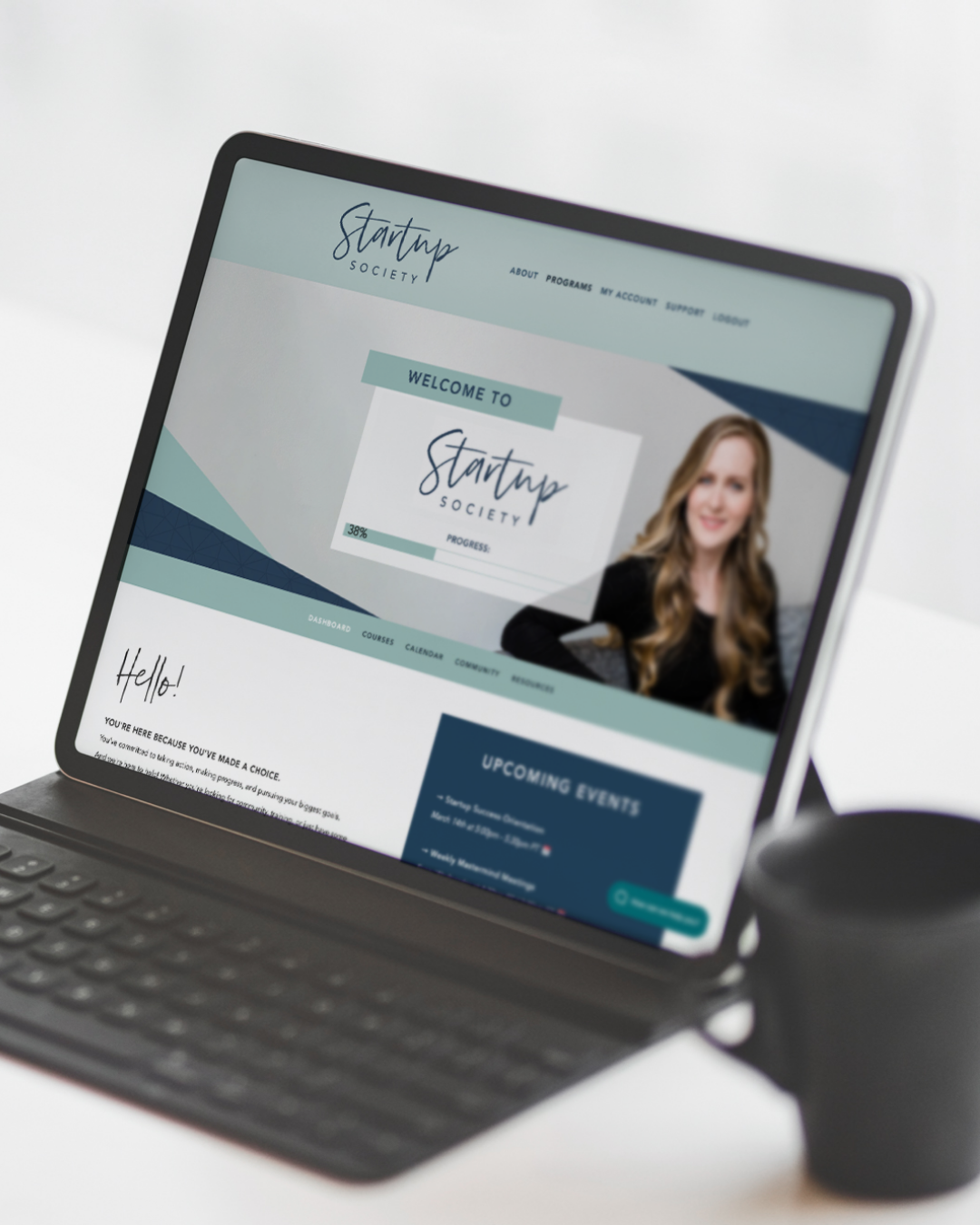How to Start Your Own Business (and make it LEGAL)
My sister-in-law wants to start a business as a wedding planner, and she’s been working with clients for a few years now. It's not an official business, and she's not making any money, but she's getting her feet wet in the industry because it’s a passion she wants to pursue.
What's stopping her from opening up an official business?
She’s feeling overwhelmed with the process and necessary steps required to start that business and make it legal.
Maybe you’re relating to my sister-in-law right now. You want to start your own business, but you have no idea what the necessary tasks are to set up shop, and you're feeling overwhelmed by all the unknowns.
If that’s you, stick with me, because we are breaking down the 7 basic – but completely necessary – steps you need to take to officially and legally start your business. This article isn’t meant to give you strategies on how to make money. Rather, I’m going to help you get your business off the ground with the one-time administration tasks so you can check those off your list and grow from there!
Step 1 – plan your business
You don’t need to write a 10-page business plan before you start, but it is essential to make some basic plans about your business before diving in.
Here are a few questions you want to consider as you plan your business:
What business are you starting? Which business idea are you wanting to test?
What will your business sell? Will it sell physical or digital products, or will you offer services?
What value will your product or service provide for your customers? Why will they want to buy from you?
If you want help getting started with your business plan, you can download the Easiest Business Plan Ever template and watch my Small Business Planning series.
Outside of that, you will want to decide what to name your business. Are you going to give it a fun, catchy name, or will you go with your own name and create a personal brand?
Step 2 – register your business
The next thing you need to do is to register your business with your state or country. This step officially and legally starts your business.
Disclaimer: I am not a lawyer or an attorney, so I can’t give you legal advice on how to start a business. This is for general informational purposes only. Do your own research.
You will want to research how to start a business in your own state or country because this can vary from place to place. I am sharing how to register a business based on living in the United States. The process is quite similar in many other countries, though. If you’re not living in the states, this can be a great starting place for you, but I recommend looking up some specifics based on your own country.
Honestly, it’s quite easy to start a business in the U.S., and there aren’t too many hoops you need to jump through. The overwhelm usually comes from needing to figure out just what the couple of hoops are. Your real complication will begin when you scale your business and hire on employees or contractors to help you. However, when you’re at that point and making good money, you can (and should) hire help from an accountant or lawyer.
Why choose a business name
You can choose to do business under your own name as a sole proprietor without officially registering your business with the state or complying with other legal requirements. However, you also will have no legal protection, and your business assets will not be separated from your personal assets.
If you give your business a catchy name, you will need to register it with your state. It is illegal to do business under anything other than your name if it is not officially registered.
There are a few benefits to giving your business a name:
It will make your business official.
It will give a more professional feel.
It will create a separation between you and your business.
It will protect your personal assets from any business liabilities.
How to register your business name
Registering your business name is as simple as filing a piece of paperwork online and paying a small fee. The easiest way to find out the legal requirements for you personally is to Google “register business name in (insert your state or country).”
The Small Business Administration also has a complete guide that dictates whether or not you need to register your business name and how to do it.
Free Checklist to Start Your Business Legally
Step 3 – get a business tax ID number
A business tax ID number (your EIN) is equivalent to a social security number for your business. Some places require both a federal and a state tax ID number, so you will need to check what those specific requirements are for you.
Registering for your business tax ID number is a very simple process. All you need to do is fill out a form on the IRS website!
Your EIN is important for many reasons, as you need it to open a business bank account and to pay your taxes. The Small Business Administration has a guide that walks you through how to get state and federal tax ID numbers.
Step 4 – get any necessary business licenses
Most small businesses don’t need business licenses in the U.S. depending on the industry and what state the business is in.
The best way to know if you need to look into business licenses is to Google “(your state name) and business license requirements” or “(name of your country) and business license requirements.”
The Small Business Administration has a guide to help you decide if you need either a federal business license or a state business license. You may need both or none at all.
Step 5 – set up your business finances
One important step in the setup process is to separate your business finances from your personal ones. This will help you stay organized and create a clear separation between your business and your personal life. It also creates a degree of protection for your personal assets if at some point you run into any legal issues with your business.
Open a business bank account
It’s good practice to run all your business transactions – income and expenses – from a separate bank account to your personal one. One huge reason for this is because it makes tax time that much easier! You will be able to easily see how much your business spent and earned over the course of the past year.
Opening a business bank account is as easy as going to the bank of your choice and asking to open one. The one thing you need to bring along outside your personal ID is your federal tax ID number (EIN). If you don’t have that, they will not be able to open an account for you.
Set up a business bookkeeping software
You will need a way to keep good records of any and all transactions coming in or going out from your business. If you aren’t at the point where it makes sense to hire a bookkeeper to help you, choosing a bookkeeping system or software that works for you will be essential.
Here are three different systems you could choose from:
A simple spreadsheet – you can create your own spreadsheet to track your income and expenses.
An app called Wave – this is a free option that moves your financial tracking into a more systemized online program.
Premium QuickBooks or Xero – these types of software programs come at a cost, but they are very organized
When first getting started, I recommend starting with a spreadsheet because it gives you a chance to be more hands-on with your books and understand the backend financial processes of running a business.
As you increase the volume of your transactions, you can move to a more full-featured software such as Wave. Once you’re ready for an actual program-based bookkeeping software, I recommend this one because it’s free and easy to use. You don’t need a fancy bookkeeping program right away.
If you’re going to work with a bookkeeper, they most likely will have a software they prefer using, and at that time, they can help you move your financial records over to that platform. So don’t worry about starting with the more elaborate software in the beginning. Start with what you will use and what will work for you.
Free Checklist to Start Your Business Legally
Step 6 – branding design
People can only interact with your business if they can see your business in some way. If you have a brick and mortar company, they can see the building, signage, and the atmosphere inside. Your website is your online presence for potential customers to get a feel for what you do.
Even though we wish it weren’t true, people do judge a book by its cover, and this is the same with business. Potential customers will look at your branding and make assumptions based off it: They will decide on the quality of your products or services based off the quality of your brand design.
In order to create a professional appearance and appeal to your audience, you need to create a personalized branding design for your business. This includes choosing specific colors and fonts, creating a logo, and building an overall aesthetic of your brand.
One choice you will make – are you going to design your own branding, or will you hire a professional to help you?
Most entrepreneurs starting out are limited in budget and choose to go the DIY route. I really believe that is a smart move for you initially too because it will help you discover what you want your brand to look like. When you work things out on paper, it really opens up your creativity and helps you decipher the emotion, mood, and overall feel you want your business to exude.
And… you can always uplevel your brand by hiring a professional later down the road.
Here are 4 tips to DIY your brand design:
Look for inspiration from other brands – find ideas from others but do not copy them.
Choose how you will design your brand – use an easy design tool like Canva.
Keep your designs simple and consistent – this will help them feel more professional.
Choose a color palette and 2-3 fonts for your brand – giving a simple and consistent look.
Once you make those decisions, stick to them! The most important thing is to create a simple and consistent brand because it will feel neat and less cluttered. Remember, first impressions are everything!
Step 7 – create a business website
I’ve put creating a business website as step 7 because it’s not legally necessary for you to begin, but it is the face of your online business. You don’t need it to get started, but it will be a great way to point people back to what you do.
If someone wants to do business with you, you will want to make it as easy as possible for them to buy your products or hire you for services. Local businesses also need an online presence for people to find out more about them and decide if they want to visit those locations.
The good news is that your website DOES NOT need to be fancy or distracting with too many bells and whistles. If you give too many options, your target customer will get confused and leave without purchasing anything.
When I first started out, I used WordPress and wasted A LOT of time – literally a couple of years – trying to get my website to do what I wanted it to do. I wasn’t going all fancy, but I also wasn’t a professional web designer, so it made it that much more difficult.
WordPress has come a long way and is now easier to maneuver for the technically challenged, but there are so many other options to choose from that are more user friendly and built for non-designers. Squarespace is one of my favorites because I find the platform to be a simple way to create a professional design, and it's very easy to learn and use.
Essential website pages
When you’re first starting out, keeping that website content as simple as possible will get you on your way faster and more effectively.
Here are the pages I recommend you create initially for your website:
Home page – this is an overview of your business and directs them to the action you want them to take.
About page – this explains who you are and what you do.
Shop page – this is where people can find out what you offer and how to purchase a product or work with you.
Contact page – this is a way for people to get in touch with you.
Adding the additional pages is not necessary – at least in the beginning.
These setup tasks do not officially grow your business, as they won’t make you any money. However, you can literally check all of these setup tasks off your to-do list for good in just a few weeks, and once you check them off, you can focus on what WILL make you money.
If you’re feeling the overwhelm of officially getting started and making your business legal like my sister-in-law was with her wedding planning business, join me in SET UP SHOP! This is a 4-week program geared toward entrepreneurs who are ready to check off the setup tasks as quickly and effectively as possible. This will create a solid foundation for you to grow your business to six figures and beyond!
set up shop is included in startup society!
Learn exactly how to build your business as quickly and easily as possible so you can feel confident you're on the right path -- and we promise to guide you every step of the way.
Set UP Shop is included for FREE inside Startup Society!






